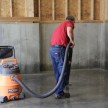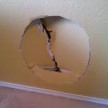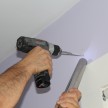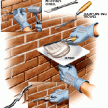Repair A Cracked Masonry Wall With Helical Reinforcing Rods
Masonry Wall Repair
Dear Concord Carpenter,
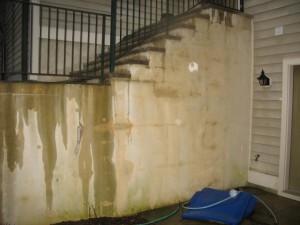
How would you approach this repair?
Would you excavate the crack for hydraulic cement sand then install re bar staples to help stabilize the crack?
Thanks, Jim
Dear Jim,
Based on the photos the stair well looks fairly solid.
I would suggest that you excavate the cracks with a grinder, masonry chisel or a hammer drill chisel. Clean out the crack so the opening slants in at an angle – similar to a dovetail. This helps hold the hydraulic cement in place.
Clean out the crack with a stiff brush and a hose.
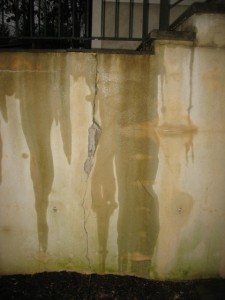 Your suggestion of installing re-bar “staples” to span the cavity is a good one. Drill holes for the re bar and also a channel to recess the re bar.
Your suggestion of installing re-bar “staples” to span the cavity is a good one. Drill holes for the re bar and also a channel to recess the re bar.
Fill the crack cavity with hydraulic cement and install the re bar with epoxy.
Repair A Cracked Masonry Wall With Helical Reinforcing Rods
Alternatively you can clean out a channel with a grinder or masonry chisel and install recessed helical reinforcing rods.
Masons often refer to these rods as crack stitching bars. They are used to redistribute loads and enhance the tensile strength back to the masonry.
A helical rods is usually a stainless steel reinforcing bar for repairing cracks in masonry walls. Helical bars have the tensile strength twice that of re bar. Helical rods are cold rolled shaped wire and have a twisted shape and are ideally suited for crack stitching repairs and masonry wall reinforcement.
When anchored across fractures helical rods reinstate the structural integrity of the cracked walls by distributing the cumulative load across the full load of the rod.
Based on your photos I would install a minimum of four helical rods.
Set you helical rods into and cover with a high performance structural repair grout for bonding reinforcing bars into masonry walls. The structural repair grout consists of cement / polymeric resin powder component and liquid component, which when mixed yields a super strong repair.
After repairs I would apply an epoxy stucco to entire staircase to cover over everything.



